

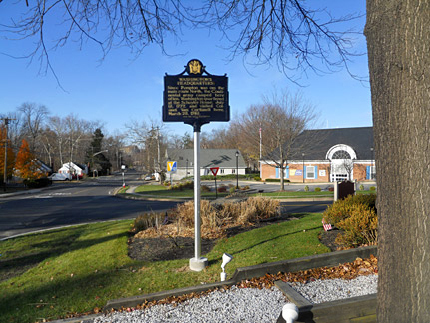
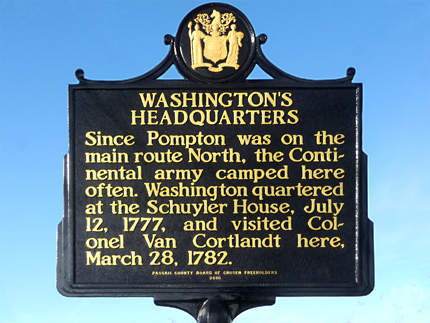
Washington's Headquarters Marker
Wanaque Ave. and Hamburg Tpk.
Map / Directions to the Pompton Lakes Washington's Headquarters Marker
Map / Directions to all Pompton Lakes Revolutionary War Sites
Site of the Yellow Tavern [1]
At this location in the 1700's stood a house owned by a man named Casparus Schuyler, part of the Schuylers who were a prominent family in the area. During the Revolutionary War, Casparus Schuyler rented the house to a man named Mr. Curtis, who ran it as a tavern with his two sisters. The tavern was known as the Yellow Tavern or the Yellow Cottage. Due to army encampments in and around Pompton, the military supplied much of the tavern's clientele.
A French officer named François Jean Chastellux, who came to America and traveled through it during the Revolutionary War, wrote this colorful account of a visit he made to the Yellow Tavern in December 1780: [2]
(Note that Chastellux spells Curtis as "Courtheath".)
"Approaching Pompton, I was astonished at the degree of perfection to which agriculture is carried... The night, which surprised me on my journey, deprived me of the beautiful prospect this country would have continued to afford. Being very dark, it was not without difficulty I passed two or three rivulets, on very small bridges, and got to Courtheath's Tavern. This inn is lately established, and kept by young people without fortune, consequently the best parts of the furniture are the owner and his family. Mr. Courtheath is a young man of four and twenty, who was formerly a travelling dealer in stuffs, toys, &c. The depreciation of paper money, or perhaps his own imprudence so far ruined him as to oblige him to leave his house at Morristown, and set up a tavern in this out of the way place, where nothing but the neighbourhood of the army can procure him a few customers. He has two handsome sisters, well dressed girls, who wait on travellers with grace and coquetry."
The building was torn down circa 1890-1900. The site where it stood is now the triangle island in the middle of the intersection that contains a sign marking it as Washington's headquarters.
This sign refers to two times when Washington made his headquarters at Pompton, although in each case, the dates on the sign are a bit inaccurate. [3] There is some uncertainty as to exactly where Washington stayed at these two times in Pompton. He may have stayed here at the Yellow Tavern, or he may have stayed at the Schuyler-Colfax House, which is located a mile south down Hamburg Turnpike from this sign. It is also possible that he stayed at a different house each time, or that he may have visited both. The details of the two visits to Pompton appear below.
July 11-14, 1777 [4]
In July 1777, General George Washington and the Continental (American) Army traveled from Morristown through New Jersey towards an area known as the Clove in New York State (now called Suffern). They reached Pompton on July 11 and remained here for the night. Washington had intended to march out of Pompton on July 12, but heavy rains prevented it. The bad weather continued on July 13, and their departure was again delayed.
On the morning of July 14, the rain had stopped, and they were able to resume their march to the Clove. However, due to the several days of rain, the dirt roads were very muddy and difficult to march on. They made slow progress, making it only about four-and-a-half miles that day, to what is now Oakland, where Washington made his headquarters at the Allen House. The day after that, the roads had improved, and they were able to march to the Clove.
March 30-31, 1782
General George Washington spent the winter of 1781-1782 in Philadelphia with his wife Martha. At that point, most of the major fighting of the Revolutionary War had ended, following the American victory at Yorktown, Virginia on October 19. Because of this, Washington was able to spend his first winter away from his army since the war began in 1775, and to enjoy a more relaxed time in Philadelphia, which was then the largest city of the newly formed United States, and a center of society and culture.
George and Martha left Philadelphia on March 22 and traveled across New Jersey en route to Newburg NY. [5] After stopping along the way at Trenton, Morristown, and Troy Hills, [6] they reached Pompton on March 30. (The historic sign incorrectly states March 28.)
While at Pompton, General Washington visited Colonel Philip Van Cortland, who was stationed here with a group of New York militiamen. George and Martha Washington left the area the following day, and they then continued on to Newburgh, New York, where Washington would make his headquarters for the next three months. [7]
The official end of the war came a year later with the signing of the Treaty of Paris on September 3, 1783, although due to the slowness of ship travel across the Atlantic Ocean at that time, the news of the treaty's signing did not reach America until October 31.

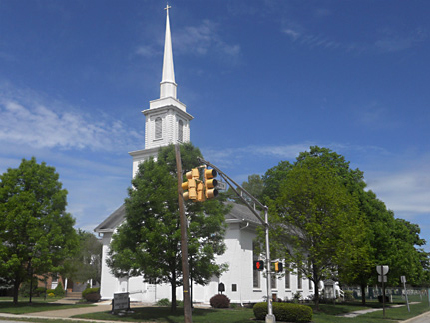
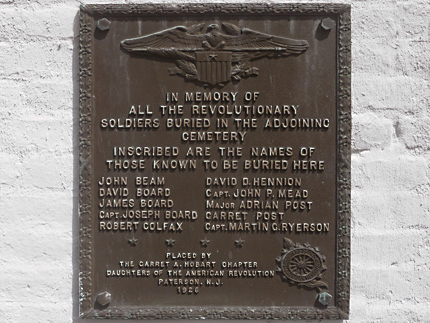
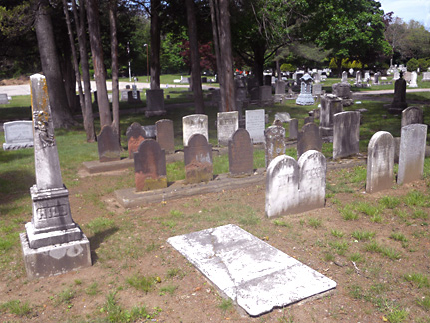
Pompton Reformed Church Cemetery
59 Hamburg Turnpike
Map / Directions to Pompton Reformed Church Cemetery
Map / Directions to all Pompton Lakes Revolutionary War Sites
A plaque on the front of the church pays tribute to ten Revolutionary War soldiers who are known to be buried in the cemetery: [8]
John Beam
David Board
James Board
Capt. Joseph Board
Robert Colfax
David D. Hennion
Captain John P. Mead
Major Adrian Post
Garret Post
Captain Martin G. Ryerson

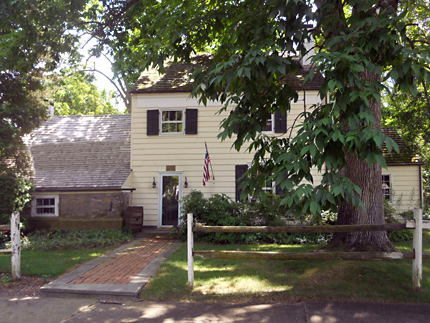
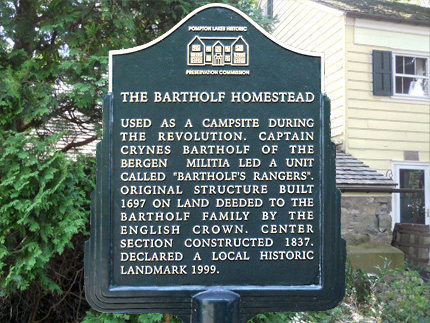
Bartholf Homestead
322 Broadway
Map / Directions to the Bartholf Homestead
Map / Directions to all Pompton Lakes Revolutionary War Sites
This house is a private residence.
Please respect the privacy and property of the owners.

1 ^ Marquis de Chastellux, Travels in North-America, in the Years 1780—81—82 (American Edition, reprinting the text of an edition translated into English and released in 1787) (New York, 1828) Pages 158 - 160
Available to be read at the Internet Archive here
▸ Chastellux account of his stop at Pompton on December 17, 1780 establishes that the tavern was run by a Mr. Curtis (Spelled Courtheath is this book) and his two sisters.
It also establishes that Curtis did not own the house where he ran the tavern, but was renting it by bartering.
Chastellux does not mention who the actual owner was that Curtis was renting from, and so makes no mention of Casparus Schuyler.
The house's connection to Casparus Schuyler is mentioned in the two following articles, along with other details not mentioned by Chastellux:• "Pompton's 'Little Yellow House' at the Crossroads," Bulletin of the Passaic County Historical Society, Volume III, Number 11, September 1952, Pages 67-68
Available as a PDF on the Lambert Castle website here
(Note: although the article is on pages numbered 67-68 in the Newsletter, it appears on the third and fourth pages of this PDF Document.)
• Susan Royal, "Travelers' Haven Now Traffic Isle," Suburban Trends [Riverdale], March 21, 1965. Page 2
Accessed through the Suburban Trends Digital Archives at the Riverdale Public Library; 93 Newark Pompton Turnpike,
Riverdale, NJ.▸Neither of these two article mentions any other source for their information other than Chastellux.
Both mention Casparus Schuyler in connection to the house, but with different details. The 1952 article has been followed more closely in the entry above.
▸ ▸Both articles give the same incorrect date of March 28 for Washington's arrival at Pompton in 1780, which also appears on the historic sign here. (See Source Note 7 below for more information about this.2. ^ Marquis de Chastellux, Travels in North-America, in the Years 1780—81—82 (American Edition, reprinting the text of an edition translated into English and released in 1787) (New York, 1828) Pages 158 - 159
3. ^ This sign, which was erected by the Passaic County Board of Chosen Freeholders in 2010, is an exact replica of an earlier sign at this location which had been placed here in 1932. It is one of a series of signs from 1932 that were reproduced in 2010.
An article about this series of historic signs can be read at the NorthJersey.com website here.4. ^ Washington's letters and documents from July 11-13, 1777 are marked "Pompton Plains."
A number of them can be read at the National Archives website here• Washington's General Orders for July 11-13 show that he originally intended to march out of Pompton on July 12, but was delayed by the rain:
~ “General Orders, 11 July 1777,” Founders Online, National Archives (http://founders.archives.gov/documents/Washington/03-10-02-0243 [last update: 2016-03-28]). Source: The Papers of George Washington, Revolutionary War Series, vol. 10, 11 June 1777 – 18 August 1777, ed. Frank E. Grizzard, Jr. Charlottesville: University Press of Virginia, 2000, pp. 247–248.
~ “General Orders, 12 July 1777,” Founders Online, National Archives (http://founders.archives.gov/documents/Washington/03-10-02-0249 [last update: 2016-03-28]). Source: The Papers of George Washington, Revolutionary War Series, vol. 10, 11 June 1777 – 18 August 1777, ed. Frank E. Grizzard, Jr. Charlottesville: University Press of Virginia, 2000, pp. 251–252.
~ “General Orders, 13 July 1777,” Founders Online, National Archives (http://founders.archives.gov/documents/Washington/03-10-02-0259 [last update: 2016-03-28]). Source: The Papers of George Washington, Revolutionary War Series, vol. 10, 11 June 1777 – 18 August 1777, ed. Frank E. Grizzard, Jr. Charlottesville: University Press of Virginia, 2000, pp. 263–267.
• Washington's letter to John Hancock on July 14, 1777 shows that Washington and his troops had left Pompton that morning and arrived at the Allen House after a difficult march "owing to the Roads which have become extremely deep and miry from the late Rains":
~ “From George Washington to John Hancock, 14 July 1777,” Founders Online, National Archives (http://founders.archives.gov/documents/Washington/03-10-02-0270 [last update: 2016-03-28]). Source: The Papers of George Washington, Revolutionary War Series, vol. 10, 11 June 1777 – 18 August 1777, ed. Frank E. Grizzard, Jr. Charlottesville: University Press of Virginia, 2000, pp. 277–278.
• See the Oakland page of this website for more about Washington's stay at the Allen House on July 15, 1777
5. ^ “From George Washington to John Laurens, 22 March 1782,” Founders Online, National Archives (http://founders.archives.gov/documents/Washington/99-01-02-08031 [last update: 2016-03-28]). Source: this is an Early Access document from The Papers of George Washington. It is not an authoritative final version.
▸ In this letter, Washington states that he would be leaving Philadelphia that day, March 22, 1782• Ron Chernow, Washington: A Life (New York: The Penguin Group, 2010) Page 425
▸ Chernow writes, "After George and Martha Washington had enjoyed their fill of Philadelphia politics and society, they took up residence in late March on the Hudson River in their new headquarters in the town of Newburgh."
Chernow does not mention the stop at Pompton, or any of the stops in New Jersey. However there is no reason to assume that George and Martha would have made the journey separately from Philadelphia to Newburg.6. ^ Washington's letters during this period are marked Trenton and Morristown.
A number of them can be read at the National Archives / Founders Online website here• The stop at Troy Hills is established in the first letter described in Source Note 7
7. ^ Washington's presence at Pompton on March 30-31, 1782 can be established in the following documents:
~ Washington letters from March 28 are marked as being sent from Morristown.
Some are available to be read at the National Archives / Founders Online website here~ “From George Washington to Henry Knox, 30 March 1782,” Founders Online, National Archives (http://founders.archives.gov/documents/Washington/99-01-02-08057 [last update: 2016-03-28]). Source: this is an Early Access document from The Papers of George Washington. It is not an authoritative final version.
▸ This letter is marked "Pompton," which established that Washington was at Pompton March 30, 1782.
▸ The first sentence of the letter reads "Your favor of yesterday’s date came to my hands just as I was leaving Mr Lots house; your Messenger came on with me to be the bearer of this."
This is most likely a reference to the home of Abraham Lott in Troy Hills, which would have been on Washington's route from Morristown, where Washington was on March 28.
This establishes that Washington did not arrive in Pompton until March 30.
~ “From George Washington to Henry Knox, 30 March 1782,” Founders Online, National Archives (http://founders.archives.gov/documents/Washington/99-01-02-08056 [last update: 2016-03-28]). Source: this is an Early Access document from The Papers of George Washington. It is not an authoritative final version.
▸ This letter, written later the same day, is marked "York Hutts," a reference to the huts of the New York Militia troops under the command of Van Cortland, stationed at Pompton.~ “From Benjamin Walker to William Heath, 31 March 1782,” Founders Online, National Archives (http://founders.archives.gov/documents/Washington/99-01-02-08059 [last update: 2016-03-28]). Source: this is an Early Access document from The Papers of George Washington. It is not an authoritative final version.
▸ This letter is marked Ringwood Manor, which is about ten miles north of here, and on the route to Newburg. Its text makes it clear that Washington was en route to Newburg that morning:
"I am ordered by the Commander in Chief to acquaint you that he will arrive this day at his Quarters at Mr Hasbrooks at Newburg..."8. ^ Placed by the Garret A. Hobart Chapter, Daughters of the American Revolution, Paterson, NJ, 1926